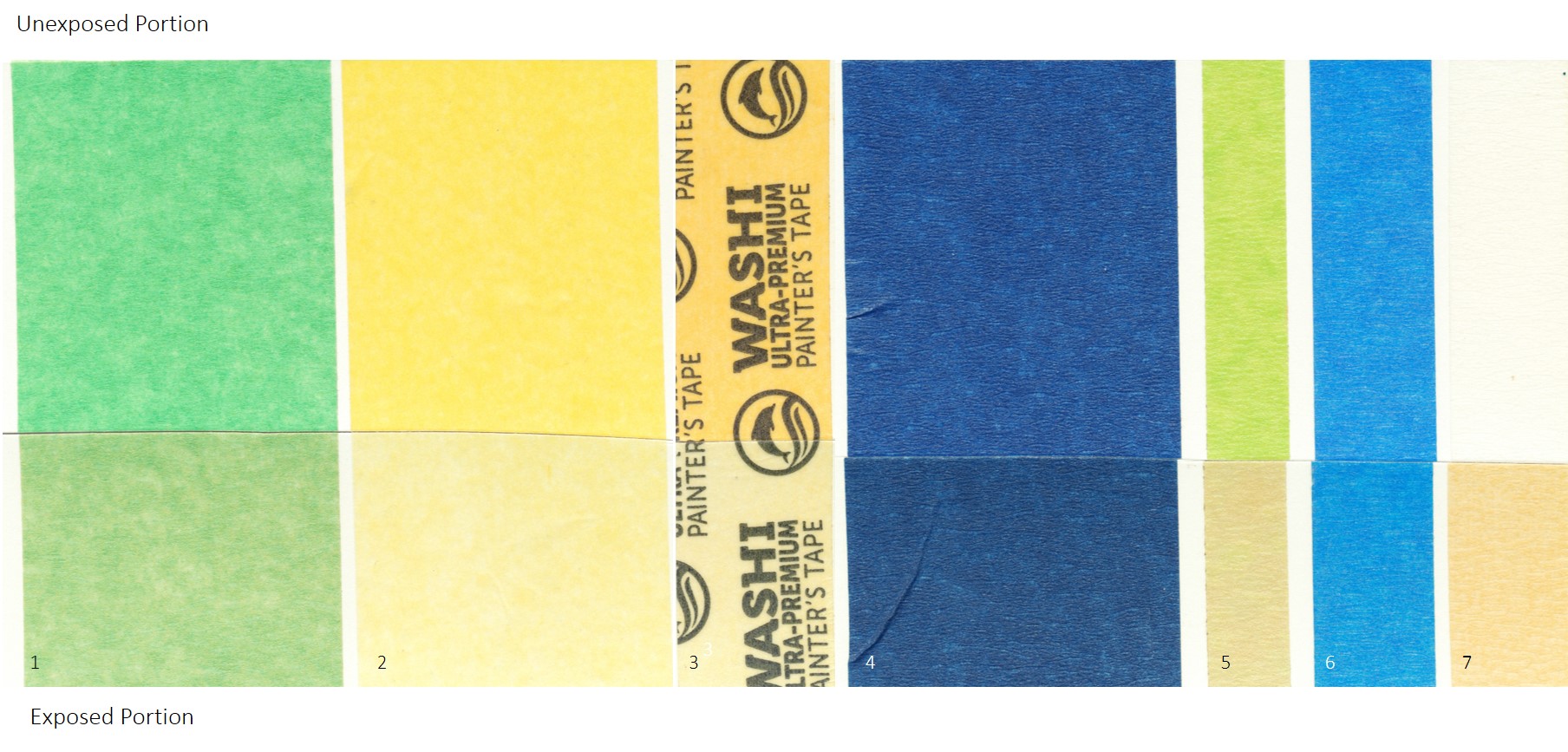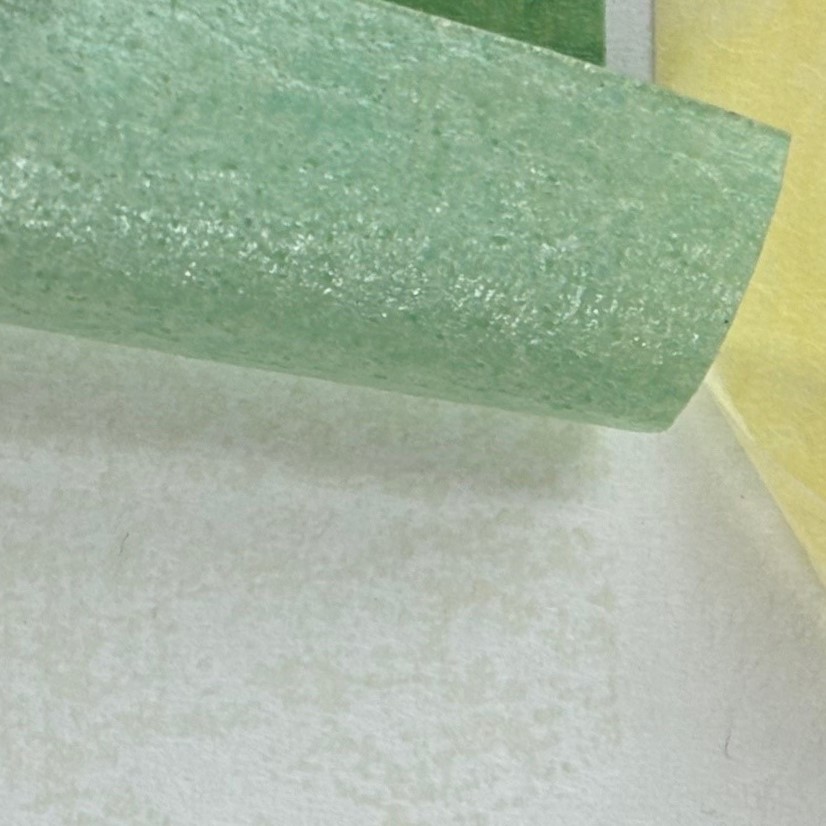Tape is an immensely useful tool for artists and designers. It is a go-to option when masking off areas of a painting or establishing the layout of a design. Masking tapes and painter’s tapes are uniquely designed to offer low tack adhesion and easy release, making them perfect for these applications. That being said, some artists like to use tape as a medium or collage material in their mixed-media art. While this would be considered an off-label use of these products, our Lab decided to test a few commonly used painter’s tapes to see how they hold up to lightfast testing. Below are the methods we used, observations and considerations when using tape within a work of art.
Testing Methods
We used painter’s tape from seven different brands we had on site at GOLDEN (see brands below) and a readily available paper surface, the back of an uncoated drawdown card (cardstock). We then cut each in half to have both a control and sample for lightfast testing. Each test sample had radiant exposure within our xenon arc chamber for 410 hours, which is equivalent to roughly 100 years of indoor gallery lighting conditions. Once complete, color, adhesion to the card stock and brittleness of the tape were assessed.
It is important to note that this testing is simulating long term aging through accelerated aging, and tapes may evolve differently over time in different environments. Additionally, to be fair, these tapes were not designed with lightfastness in mind and their adhesive was intended to be weak for masking and easy release from surfaces. Our evaluations were not for their intended use, but how they might live within a work of art over a long period of time.
Results

Color
In most cases, there was some change in color ranging from a slight dulling to more noticeable fading or darkening. Blue painter’s tapes seemed to retain color the best from this grouping with Scotch Blue® Original #2090 showing the least amount of change overall. The worse example came from the White Masking Tape, which showed significant darkening and yellowing.
Adhesive Strength
All tapes were checked against their controls and when it came to the adhesive strength after exposure testing, it varied a bit. Painter’s Mate Green® and the White Masking Tape separated from their adhesive leaving behind a residue on the surface. Washi Ultra-Premium, Uline Blue Painter’s Tape, 3M 401+ and FrogTape® Delicate Surface all became more tightly bonded to the card stock, tearing the surface when we attempted to remove them. In most cases the controls released from the paper without affecting the surface. The Uline Blue Painter’s Tape had a higher overall tack causing the paper to peel in both scenarios, but was noticeably more bonded in the exposed sample. 3M 401+ we were unable to peel up without destroying the test sample. Scotch Blue® Original #2090 was the only sample that retained a similar performance before and after exposure testing.
Embrittlement
With the two tape samples that delaminated, Painter’s Mate Green® and the White Masking Tape, there was also evidence of embrittlement and a loss of flexibility. The remaining tapes showed only a slight loss in flexibility.
Images




Conclusion
It is important to note again, that using tape as a visual element in an artwork is an off-label use and would be considered experimental in nature. It is also possible that the materials used in each tape may change over time, which could differ from these results in the future. This testing is intended to offer general observations on what could possibly occur over time when using tape in an artwork.
This also offers some insights for artists that are only using tape during the design phase or for masking. If tape is left on a surface for an extended length of time the adhesive strength could increase making it harder to cleanly remove the tape. For those using tape within an artwork, there will likely be some changes over time. For the oil painters, there are some interesting results when using tape for masking in oil paintings. The results could extend to collage and mixed media as well.
Advice
If using tape to mask, try and remove the tape as quickly as possible. If you hope to use tape as a medium, always test the tape you plan to use or embrace that there may be some changes over time. All tapes will perform differently. Hopefully, our testing will provide some context while encouraging experimentation and testing.
If you have any questions feel free to comment or reach out to us at [email protected].
About Scott Fischer
View all posts by Scott Fischer -->Subscribe
Subscribe to the newsletter today!

Really interesting and helpful article!!! Thank you!
Yes, interesting. In my experience when tapes are encased in Golden mediums on both sides they tend to change less dramatically over time or with exposure.
Hello Lisa, it is also important to note that the back of tape may have some sort of release agent to prevent the tape from sticking to itself permanently. This may affect adhesion of paints to the tape, so testing is recommended to see if it can work for you. In our article on oils and tape, this affected the applications in interesting ways. There may be some benefit to acrylics being layered over tape, if adhesion is good, but this type of sandwiching will not make a tape more archival. Acrylic mediums and paints do not have UV filtering, so depending upon the application you might want to use a varnish to reduce exposure to UV, which can lead to these changes we described in the article.
Informative and interesting thank you.
Libby we agree, in our experience pulling the tape while the paint is still wet will give you the cleanest looking lines. If acrylics dry they form a film, which can tear or pull with the tape when it is lifted. Thanks for sharing!
Thank you for this!! Ive been looking for an acid free tape that could be left in a collage once it’s been painted. I have been toying with the idea of painting m then sealing and varnishing with UV protectant. but good to see the tests you ran!!
Hello Cheryl, We are glad you found the article to be of interest! There are acid free tapes used in bookbinding and art conservation, but we have not explored or tested them. When considering their use, remember that putting a coating on top would not help with future failed adhesion unless the coating has penetrated the tape and connected to the layer beneath. Happy creating! Cathy